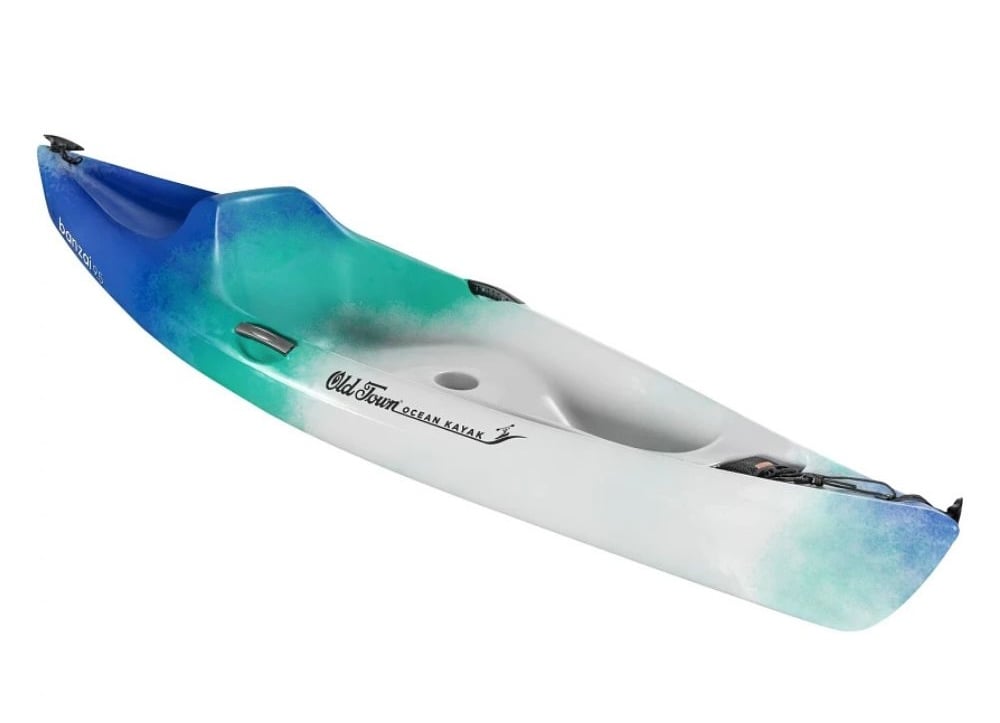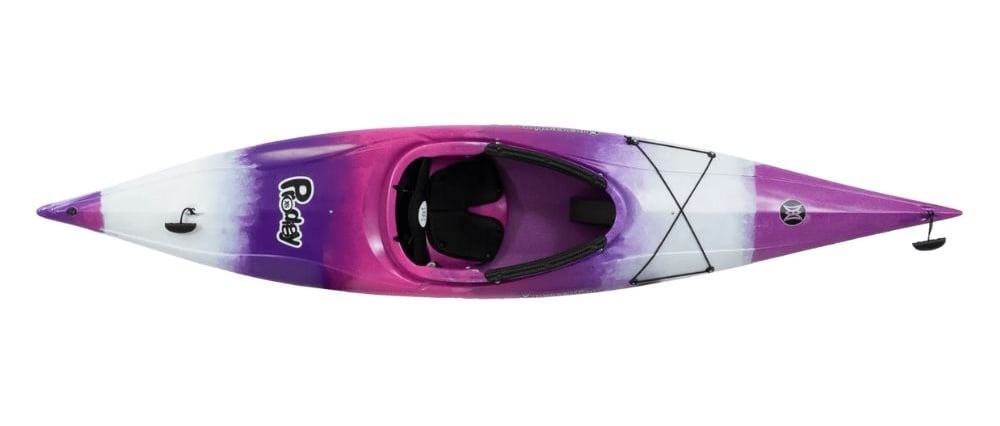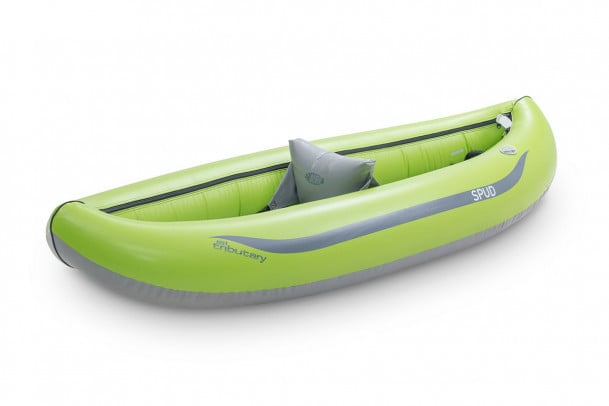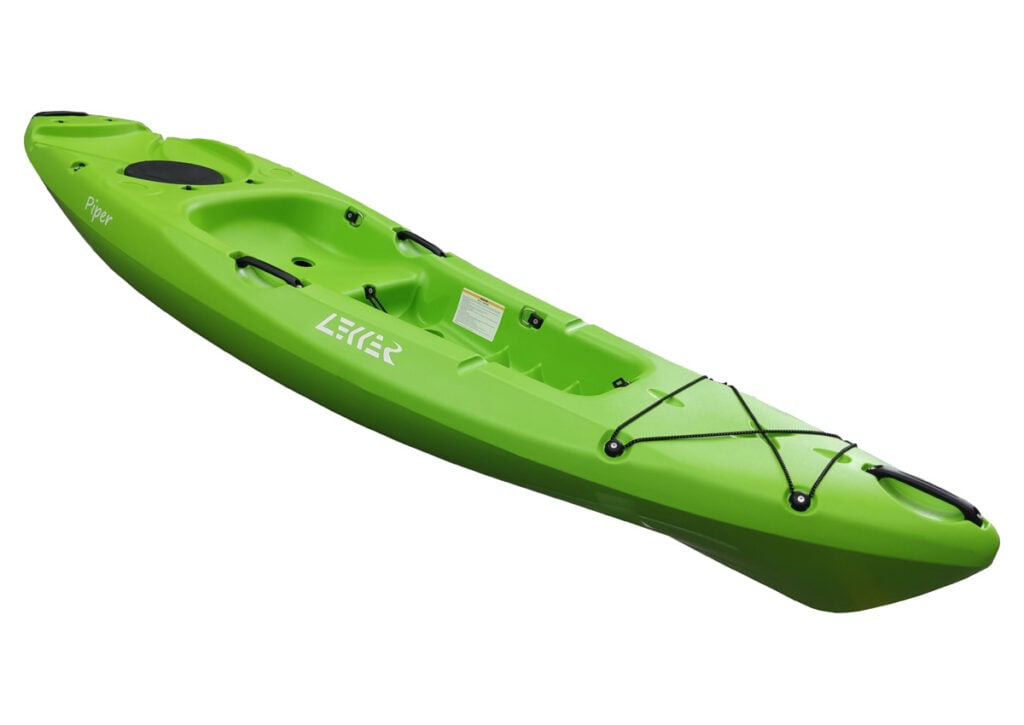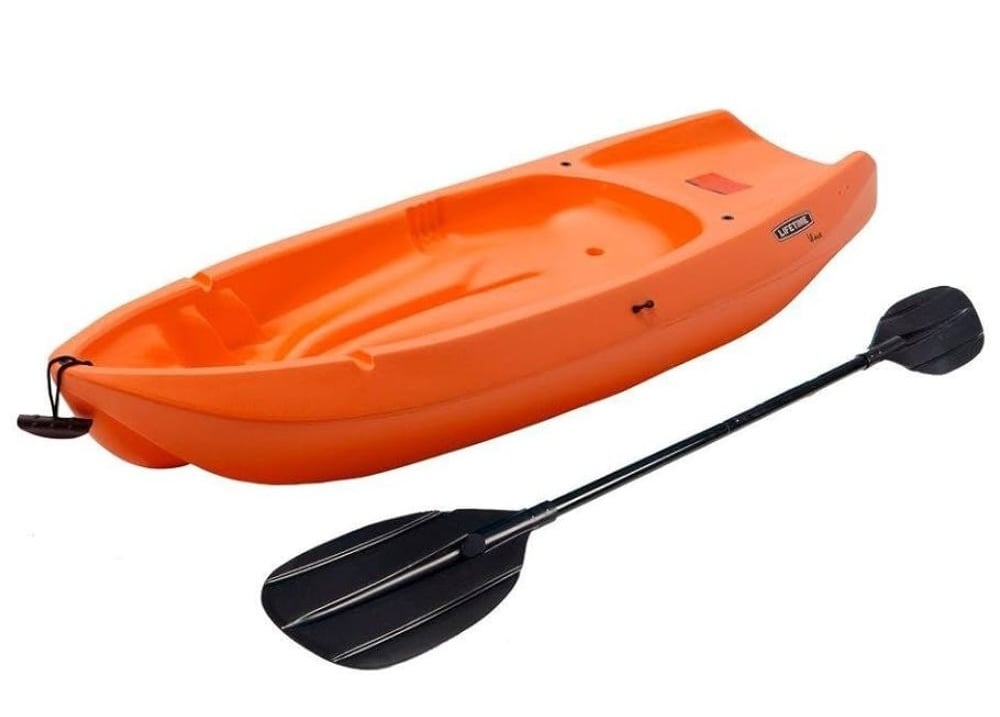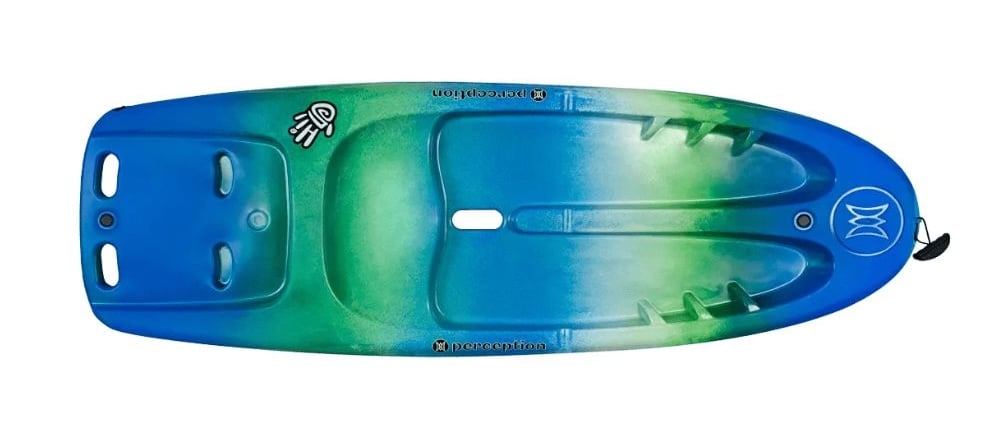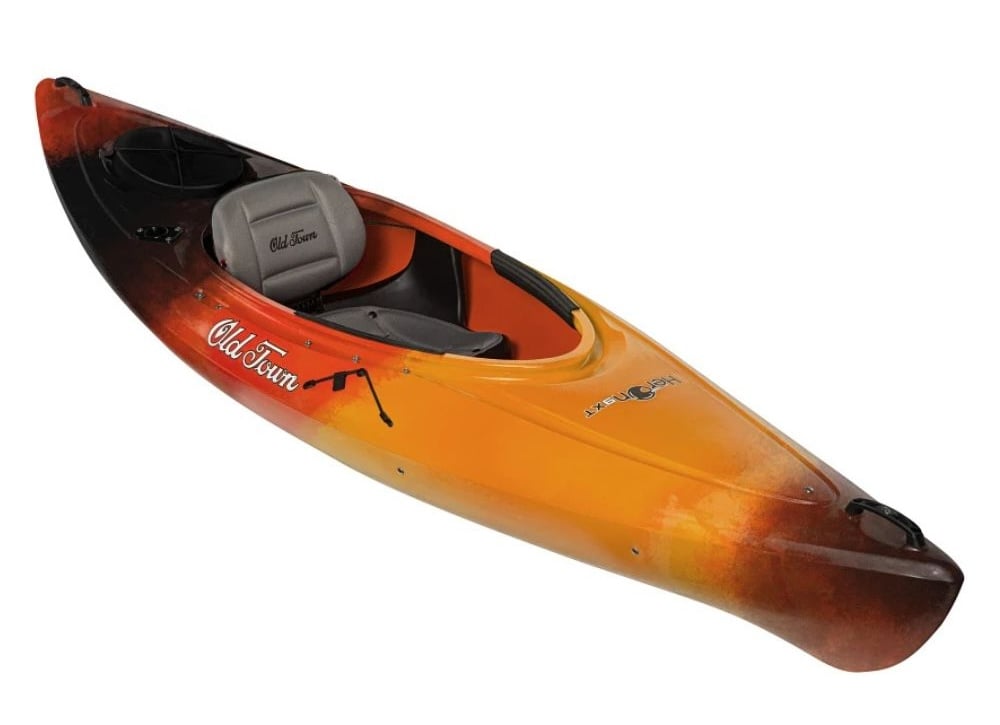There may be no feeling more fulfilling for a paddler than the opportunity to share the water with the next generation of young paddlers. Tandem kayaks are a great solution for getting young children on the water, but once they’re old enough, most kids will want to pilot their own kayak.
Ensuring kids have a positive experience means getting them a kayak (and paddle) that fits their smaller bodies and is lighter and easier to maneuver. Even small adult kayaks are too wide and deep for most kids to easily reach the water with their paddle. If you want children to have a safe and enjoyable paddling experience, youth kayaks and paddles offer dimensions and designs suitable for kids.
The first question parents often ask is, how old does a child need to be to paddle solo?
The answer depends on what you hope to accomplish on the water. If you’re out for a fun float with the family and don’t have to make miles, younger children (ages 5 and up) will have a blast piloting their own kids kayak. From ages 5 to 12, kids can easily paddle short distances on calm waters in their own child-sized kayak. If you’re on a family kayak tour that will cover more distance, little ones won’t be able to keep up. For ambitious trips, small children are best paired with adults in tandem kayaks.
A good way to think about kids paddling their own kayak is to compare it to bicycling. You can put a very young child on a strider bike and she’ll have fun riding to the end of the block and back. If you think the same child would enjoy a 5-mile road ride, forget it. The only real way to know what your children are capable of is to get them out on the water with the appropriate gear. With experience, you’ll know what they can handle.
Once children are ready to paddle a kayak on their own, it’s time to find the best kids kayak for their age and paddling goals. Read on to find advice on buying a new or used youth kayak, as well as resources to help narrow your search.
Top picks: Best kids kayaks for 2025
Ocean Kayak Banzai 9.5
Ocean Kayak Banzai 9.5 Specs
Length: 9’6″
Width: 28.5″
Weight: 36 lbs
Capacity: 194 lbs
MSRP: $499.99 USD
johnsonoutdoors.com
Buy from:
OLD TOWN
The Banzai recreational kayak is designed specifically for kids with a low-profile and kid-friendly seating that allows for easy movement and mobility. The Banzai’s Tag Along system lets paddlers tow their kids when they’re too tired to paddle, an essential for parents. This playful and maneuverable kayak is ideal for kids of all ages.
Perception Prodigy XS
Perception Prodigy XS Specs
Length: 10′
Width: 23″
Weight: 26 lbs
Capacity: 150 lbs
MSRP: $549 USD
confluenceoutdoor.com
Buy from:
PERCEPTION AMAZON
Unleash the confidence in the little adventurer with the Prodigy XS, a blend of stability, comfort and safety for kids and smaller-framed adults. The Prodigy XS kayak offers confidence-building stability, comfort and performance in a day touring design. The sit-in design protects the paddler from the elements and further lowers the paddler’s center of gravity to enhance stability. Kids will stay on the water longer in the Prodigy XS because it is fitted with premium outfitting not usually found on youth kayaks.
AIRE Spud
AIRE Spud Specs
Length: 7’2″
Width: 35.5″
Weight: 21.5 lbs
Capacity: 220 lbs
MSRP: $539 USD
aire.com
Buy from:
AIRE AMAZON
The Tributary Spud is a great choice for paddlers of all ages and skill levels. Its compact size and inflatable design makes it easy for mini shredders and smaller-framed paddlers to handle and store, all while staying budget-friendly. Ideal for introducing newcomers to whitewater sports, the Spud also excels as a dynamic and playful boat for more experienced paddlers.
Lekker Kayaks Piper
Lekker Kayaks Piper Specs
Length: 8′
Width: 11.5″
Weight: 26 lbs
Capacity: 120 lbs
MSRP: $390.00 USD
lekkerkayaks.com
Buy from:
LEKKER
Lekker is a new brand for 2025, however its founder Celliers Kruger has been designing kayaks for decades. Built to be stable and comfortable while also allowing for growth as a young paddler, the Lekker Piper sit-on-top kid’s kayak is a far cry from your average kid’s kayak. The Piper, designed for kids aged 5-12 and up to 130 pounds, is stable but streamlined with a long waterline to preserve speed so that a kid can more easily keep up with adults on the water. Like a touring kayak, it can be edged and turned.
The philosophy behind the design of the Piper is that kids need a boat that inspires confidence and allows for growth as a paddler early on.
Lifetime Wave Youth Kayak
Lifetime Wave Youth Kayak Specs
Length: 6′
Width: 24″
Weight: 19 lbs
Capacity: 130 lbs
MSRP: $235 USD
lifetime.com
Buy from:
LIFETIME AMAZON
Just looking to splash around at the beach? The six-foot Lifetime Wave recreational kayak is designed for kids ages 5 and up and up to 130 pounds. The 24-inch width provides a stable paddling platform to keep kids safely in the kayak. Its sloped stern and swim-up step allows the paddler to easily re-enter the kayak from the water. With scupper holes, multiple footrest positions and great stability, the Wave is ideal for kids wanting to play. Read Paddling Mag’s indepth Lifetime Wave youth kayak review to see if it’s the right fit.
Perception Hi Five 6.5
Perception Hi Five 6.5 Specs
Length: 6′
Width: 24″
Weight: 26.5 lbs
Capacity: 120 lbs
MSRP: $299 USD
confluenceoutdoor.com
Buy from:
PERCEPTION AMAZON
Drawing on the award-winning, patented Hi Life 11.0 design, the Hi Five packs all of its predecessor’s best features into a size perfect for kids. It offers an unbeatable watercraft experience with features such as a swim-up deck, ample standing surface, paddle rest, easy-to-carry handles and two solo mount accessory recesses that allow for hours of fun in lakes, ponds and calm coastal regions. The Hi Five will accommodate kids even as they grow older. Additionally, it comes with a kids’ kayak paddle.
Old Town Heron 9XT
Old Town Heron 9XT Specs
Length: 9’6″
Width: 28.5″
Weight: 40 lbs
Capacity: 260 lbs
MSRP: $649.99 USD
johnsonoutdoors.com
Buy from:
OLD TOWN
The Old Town Heron 9XT combines comfort and features at an affordable price. This is a favorite kayak for bigger kids and youth paddlers who are gaining their independence and enjoying some day touring. It’s also popular amongst young anglers. Featuring a padded Comfort Flex seat, Quick Seal hatch with bulkhead, two rod holders, a cup holder, and adjustable foot braces, the Heron 9XT is perfect for beginning and recreational paddlers who may want a few extra bells and whistles.
Shopping for a used youth kayak?
One of the biggest challenges most paddling families face when looking for kayaks is affordability. There are lots of low-price recreational kayaks available, but the majority of these are too wide for small children to paddle effectively. Other discount kayak options are little more than beach toys—short, lightweight boats are fine for horsing around but not for paddling from here to there. If you’re on a tight budget, consider scouring the used market for a quality used youth kayak rather than heading to the discount store.
As children outgrow their kayaks, secondhand kids’ kayaks find new life on the used market. Set up alerts for search terms like “kids kayak” and “youth kayak” on Facebook Marketplace, and keep these tips in mind when you find a match.
Know what type of kayak is being listed, and what kayak style is most suitable for your child. “Kids kayak” is a fairly broad term that covers a range of sizes, materials and styles of kayak. For example, a 6-foot kids kayak might be most suitable for 5- to 8-year-olds, while children ages 8 to 12 may benefit from the increased capacity of an 8-foot youth kayak. Be sure you have all the details, and ask the seller where and how they used the kayak.
If feasible, bring your kid along to scope out the kayak. Have them sit in the kayak and see how it fits. This is also a great way to bring them an immediate sense of ownership and responsibility for their kayak.
Inspect the kayak for damage before committing to a purchase. Kid kayaks are durable, but cracks or dents in the plastic hull are possible if the kayak was improperly stored. If you are at the seller’s property, pay attention to how the kayak was stored. Has it been left out in the sun and heavily faded? UV deteriorates plastic, which can lead to cracking or warping down the road.
Ask the seller to meet at a location where you can take the kayak for a test paddle. Bring a paddle, appropriate clothing and PFD or lifejacket for your child if they are going to try the kayak, and supervise their test paddle. This is the best way to see whether the youth kayak is comfortable and sized appropriately for your child.
For more tips on what to look for when selecting a used kayak, read our article How To Buy A Used Kayak.
Kids kayak buying guide
Once children are ready to start paddling their own kayak, your first question will likely be, “What should I look for in a kids kayak?” Read on for tips on choosing the right kids kayak to meet the needs of your paddling family.
Return on investment
Kayak companies know it’s good for the paddlesports industry to encourage parents to get their whole family out on the water, but the cost of producing good small kayaks isn’t much less than building bigger boats. One way around this challenge is to simplify the features in the kayaks. Children’s designs frequently have simple layouts and lack the bulkheads and hatches common in adult kayaks. Fewer options keep both cost and weight down, which makes it easier for kids to carry and control their own boats.
Of course, there are some kids kayaks nearly as full-featured as their grown-up equivalents. Children’s touring kayaks are built with all the safety features of full-sized boats, and this means you should expect the price of these kayaks to be higher. The bottom line is the closer a youth kayak is to a full-sized kayak, the closer the price will be to an adult kayak.
Performance matters
The other big challenge with children’s kayaks is performance. If you want your children to have a good time out on the water with you, they need to be in boats matched to their size and strength. It might be tempting to put kids in cheap recreational kayaks, but most of these boats are way too big for small paddlers to handle.
Small recreational boats may be short, but they are also wide. A nine-foot rec kayak will float a full-sized adult weighing 200 pounds or more. Kayaks like this are often 30 inches wide. Put a 60-pound child into this same kayak and she’ll hardly be able to reach the water with her paddle. When it comes to kids’ fun on the water, big person rec kayaks are out.
Children’s kayaks need to be matched to the paddler’s size every bit as much as adult kayaks do. This typically means being narrower than 25 inches, sometimes as narrow as 20 inches. Children under 100 pounds find such kayaks plenty stable and much easier to control.
Width is a significant factor in kayak performance, but length comes into play too. Longer kayaks are faster, but they have more drag in the water. Children don’t have the strength to power a big boat effectively. This means kid kayaks are typically much shorter than similar models geared toward adults. Almost all children’s kayaks are under 12 feet long, and many are shorter than 10 feet. The shorter length of children’s kayaks combined with less powerful paddlers means adults will need to back off a bit during a family day on the water. No kayak designed for children will keep pace with longer adult boats.
Pick the best fit
Recreational kayaks for children come in both sit-on-top and sit-inside models. These kayaks are narrower versions of adult recreational kayaks that are easier for kids to control. The benefits of sit-on-top versus sit-inside kayaks are that they can’t be swamped and are easy to climb back onto if you’re playing in the water. Sit-inside kayaks will keep children drier and warmer if the water or air temps are a little cooler. Recreational kayaks are ideal for splashing around at the beach or cottage and exploring small lakes and gentle rivers.
Kids touring kayaks are longer and narrower than recreational kayaks. They are sit-in designs with smaller cockpits. Some designs have bulkheads (interior walls within the kayak hull that ensure flotation) and storage hatches like adult kayaks. Others skip these features to keep weight and cost down. The narrower width and increased length of these boats help children to develop paddling skills and keep pace with full-sized kayaks on longer tours.
Whitewater kayaks for kids can be either sit-on-top or sit-in style. Sit-on-top designs are the best choice for casual river paddles, combining small rapids and swimming breaks. For kids who are stoked on whitewater and want to learn the more technical aspects of whitewater paddling, a child-sized sit-inside whitewater kayak is the way to go.
Once children hit about 100 pounds, you’ll have a few more options. Kayaks aimed at smaller adults are a good choice for bigger kids. These kayaks don’t come at a child’s price but they are scaled to fit a growing youngster. Small adult kayaks are a great choice as an upgrade from a child’s touring or whitewater kayak, especially if your family is getting more ambitious about spending time together on the water.
The little things
Kid-sized accessories are every bit as important as finding the right kayak. Avoid the temptation to buy inexpensive adult paddles for your children to use. These paddles are much too heavy and will almost guarantee a frustrating experience. Instead, find paddles that are lightweight and sized just for kids.
Likewise, look for child or youth PFDs or life jackets that fit well and are comfortable enough your children won’t complain about wearing them. All quality life jacket manufacturers produce good kid vests. Avoid the temptation to size up so your child can grow into it. Proper PFD fit is critical to safe and comfortable paddling.
When it comes to what to wear kayaking, you’ll want to dress kids in weather-appropriate layers, similar to how adults dress but focusing on keeping kids warm and protected from the sun and elements.
Finally, make sure you have a tow system so you can give kids a power assist if they start to get tired and fall behind.
Where to buy kids kayaks
Many major kayak manufacturers produce at least one model aimed at children. River play whitewater designs from Jackson Kayak and Pyranha should be easy to find. Perception makes an affordable touring kayak and Current Designs produces a premium composite kayak for small paddlers. Old Town makes a scaled-down sit-inside recreational kayak.
Basic sit-on-top recreational kayaks for kids are also widely available at sporting goods and discount box stores; check out Pelican, Perception, Lifetime and Sun Dolphin. This list is by no means exhaustive. New models are introduced every few years and used boats and discontinued models are widely available.
If you’re asking yourself where to buy a kayak, the best place to track down a youth kayak is at your nearest specialty paddlesports store. Shops like these may have kids kayaks in stock, and if they don’t, they’ll know where to get them. If you’re lucky, you can arrange a test paddle so your children can try on the boats for size.
Still have questions? Here are answers to some of the most common questions about kids kayaks.
-
Kids kayak weight
Kids kayaks are significantly lighter than adult kayaks, and typically range between 20 and 30 pounds. Check the manufacturer’s specifications to find the exact weight of various kids kayaks.
-
Kids kayak weight limit
A youth kayak has smaller dimensions than an adult kayak, which means less volume and a lower weight limit than kayaks intended for adults. In general, expect a weight limit of 100 to 120 pounds for most kids kayaks. Check the manufacturer’s specifications to find the exact weight limit of various kids kayaks.
-
Can an adult use a youth kayak?
Kayaks are designed for the size and weight of a paddler more so than their age. If an adult paddler falls within the recommended weight range or maximum weight capacity of a youth kayak—and they find it a comfortable fit—then an adult may be able to use a youth kayak. Keep in mind that most youth kayaks have a weight limit of 100–120 lbs.
-
What size kayak is good for kids?
The best size kayak for kids is one that is advertised as a kid-specific model. Recreational kayaks suitable for children are typically six to nine feet long and less than 25 inches wide. Kids kayaks have scaled-down seats, width and depth to allow developing paddlers to easily reach the water.
Combined with the shorter length, this creates a lighter kayak that kids can maneuver on and off the water.
- Kids kayak reviews
Looking for detailed reviews of other popular youth kayak models? Check out the expert reviews written by the Paddling Magazine team below.
- Inflatable Kayak Review: AIRE’s Spud & Tater
- Recreational Kayak Review: Old Town Otter
- Tandem Recreational Kayak Review: Ocean Kayak Malibu Two
- Inflatable Recreational Kayak Review: Intex Challenger K2
- Recreational Kayak Review: Lifetime Wave Youth
- Recreational Kayak Review: Pelican Bandit NXT 100
- Inflatable Kayak Review: Sea Eagle 370
- Boat Review: Seaward Passat G3 Kayak
- Boat Review: Liquidlogic Remix Kayak
- Inflatable Recreational Kayak Review: Innova Thaya


